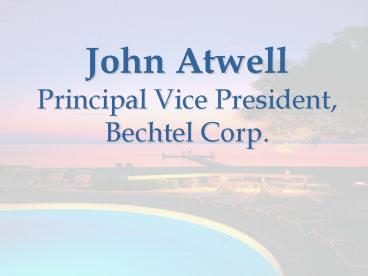John Atwell - PowerPoint PPT Presentation
1 / 32
Title:
John Atwell
Description:
The Bechtel Environment. Worldwide. Multiple Business Lines (Power, Civil, etc.) Project-oriented ... go for help. Exemplify Bechtel core values. Sets. Tone ... – PowerPoint PPT presentation
Number of Views:279
Avg rating:3.0/5.0
Title: John Atwell
1
John Atwell Principal Vice President, Bechtel
Corp.
2
- Managerial
- and
- Supervisor Effectiveness
3
Key Elements
- Environment
- Identification
- Expectations
- RRAs
- Set up for success (DCOM)
- Follow through (Trust but verify)
- Walk the Talk
4
Environment
5
The Bechtel Environment
- Worldwide
- Multiple Business Lines (Power, Civil, etc.)
- Project-oriented
- Repeat Projects (e.g. SGRs)
- First-of-a-Kind
6
Where do we start? Identification
- The Core Team
- Top down
- Project Manager anddirect reports
- Red light/green lightevaluation
- Flow down
7
Identification
- Why Top Down?
- Sets the tone and expectations
- Bring the proper expertise
- Know where/when to go for help
- Exemplify Bechtel core values
GettingHelp
Core Values
SetsTone
Expertise
8
Expectations
- Set high standards
- Safety Zero Accidents
- Performance Scope/Cost/Schedule excellence
- Productivity First time quality execution
- Clearly communicate them
- Check for understanding
9
Expectations Safety Example
- Zero accidents
- Corporation expectations established
- Driven by both business and the right thing to do
- Top down
10
Safety (cont.)
Lost Workday Case Incidence Rates
Safety on the Job
number of lost workday incidents per 100 workers
per year
11
Roles, Responsibilities Accountability
- Clearly Communicate
Roles
Responsibilities
Accountability
12
Roles, Responsibilities Accountability
- Role - Function the individual will play on the
team - Responsibility Accountable for something within
ones power and control - Accountability - Obligation to report and explain
or justify
13
Roles, Responsibilities Accountability
- Results in
- Better communication
- Fewer items slipping through the cracks
- Provides single point accountability
14
Roles, Responsibilities Accountability
15
Set Up For Success Model
- Direction
- Competence
- Opportunity
- Motivation
16
Set Up For Success Direction
- Clear where we are trying to go?
- Is it focused credible?
- Is the direction documentedthrough
- vision
- strategy
- performance objectives
17
Set Up For Success Competence
- Do they have the skills and knowledge needed to
perform the work? - Technical Skills
- Interpersonal Skills
18
Set Up For Success Opportunity
- Do they have the resources, authority, and
information needed to accomplish the tasks
- Necessary materials?
- Sufficient money/budget?
- Necessary authority?
- Sufficient people?
- Solid processes?
- Adequate place?
- Relevant information?
- Adequate time?
- Needed tools?
- Appropriate technology?
19
Set Up For Success Motivation
- Do the they "want to" do the tasks or do they
"have to" do them? - If performers are doing something because they
"have to" - If performers are doing something because they
"want to"
Result get "just enough" performance
Result get "discretionary" performance
20
Set Up For Success DCOM Gaps
D
C
O
M
X
X
X
0
Lethargy
X
X
0
X
Frustration
X
O
X
X
Rework/Cost
O
X
X
X
Chaos
High Performance
X
X
X
X
21
Set Up For Success?
22
Follow Through Feedback (R/R-)
- R PositiveReinforcement
- R NegativeReinforcement
- Trust but verify
23
Positive Reinforcement
- Provides a positive consequence following a
behavior - Maintains the behavior or increases the odds it
will take place again - Includes examples such as praise, money,
trinkets, positive feedback from a supervisor, a
day off, etc. - Leads person to like the situation
24
Negative Reinforcement
- Removes or prevents an undesired consequence to
increase the odds that the desired behavior will
occur in the future - Includes examples such as avoiding a traffic
ticket (by driving within the speed limit), or - Avoiding being reprimanded (by complying with
policies), or - Leads person to dislike the situation
25
Trust but Verify
- Ask the probing questions
- Build confidence in your personnel, correct
behavior - Improve performance
26
Walk the Talk
- Up and down theorganization
- Say what you mean
- Do what you say
- Lead by example
27
Where it all Starts First-Line Supervision
- Key to building a successful organization
- Example for the team performing the work
- Rubber Meets the Road
28
Where it all Starts First-Line Supervision
- Similar approach but at the individual level
- Identification
- Personal red Light/green Light
- DCOM
- Immerse in the details
- Provide necessary training and tools
29
Where it all Starts First line Supervision
- Management Responsibility
- Provide the right DCOM
- Set the expectations
- Hands-on supervision
- Be in the field where the work is
- Provide correction and immediate feedback
- Trust but verify and provide needed support
30
Summary
- Tailor to the Environment
- Top down
- Leadership
- Expectations
- Guidance
- Bottom up
- Technical competence
- Motivation
- Lead by example
- Hands on
31
Walk the Talk
- Up and Down the Organization/Project One Goal
Safe Execution Zero Accidents Performance
Meet or beat the project Scope/Cost/Schedule Produ
ctivity Provide First time quality of execution
32
Lets go forth and ..































